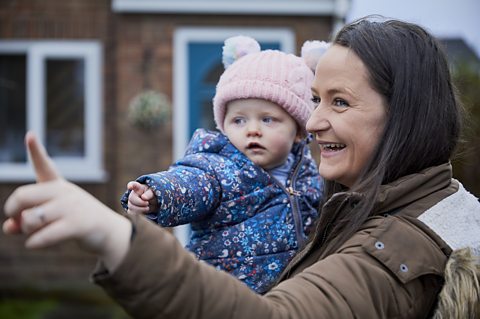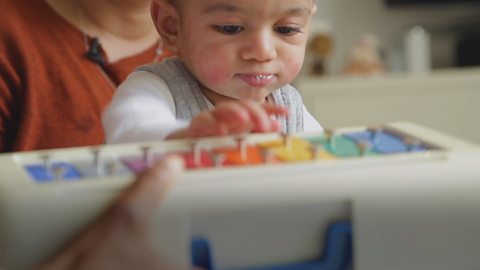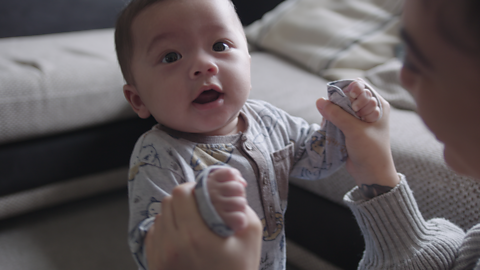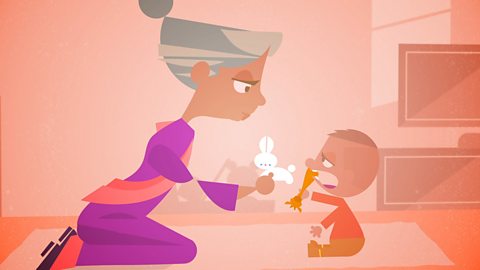Did you know that your baby learning to sit upright or stand helps them develop their speech?
Dr. Sally Payne from the Royal College of Occupational Therapists describes moments like these as 'fundamental movement skills', lots of small actions that can build on each other to allow your developing child to do so much more.
For example, your baby being able to sit on a chair frees their hands and arms to do other things. Being able to lift an arm away from the body makes it easier to put arms through sleeves and so on. It's all about building that strength and coordination to make our everyday tasks second nature.


Your baby's balancing act
It's making those movements second nature that's the key to building language skills, according to Sally.
"If you have to think about sitting and keeping your balance and not falling off the chair, then you've got less brain space to think about what you're going to say, interacting with people and the environment around you."
"It means you can't then engage in other things - so I think that's really critical."
The ability to sit up straight can be a real milestone moment for your baby. Babies and infants who are just starting to sit still need to use their hands to prop themselves up, but as their core stability improves, it frees up their hands point at or grab things they want to chat about.
And as they grow and try activities like drawing, they can communicate in all new ways.

Getting to the point
Speaking of pointing, although it's sometimes considered rude to do as an adult, Sally highlights how useful pointing is as a communication tool for children.
"You need to balance to be able to point… but also that ability to isolate your finger. It's really important for that shared learning or interaction: 'Look, there's a squirrel up in that tree!' And then we can have a conversation about the squirrel."
Isolated finger movements are key for other tasks too, like holding a crayon and using cutlery. Your baby is always on the road to learning new skills as they master older ones.

At your own pace
Every baby is different and learns new skills at their own pace. So even though learning and mastering fundamental movement skills is important, don't worry if your baby learns sitting up, pointing, or holding objects at a different time to others.
Sally says learning something like a pen grip goes through different stages: "You start with the whole-fisted hand grip, and then you get the placement of your fingers down. I don't like putting a time on it - lots of children haven't even seen a pen before they arrive at preschool."
However, over time, babies will get better with tasks like holding crayons and pens with practise and more opportunities to try.
This does mean that for children with physical disabilities, the environment that they're interacting with can be more limited. Therapists place importance on helping children with physical disabilities to move around so it can open up more opportunities to communicate and interact.

Head, Shoulders, Knees and Toes
Although the timeline of babies learning fundamental movement skills will vary, there is an order that most babies follow as part of their physical development.
"Our children develop strength and stability from the middle of the body outwards," says Sally.
"They start off by getting control in the shoulders with very big movements, like crawling. Crawling also improves control and supporting weight on the elbows and wrists, shifting weight from hand to hand, which is brilliant for enabling children to explore their environment. And if we think about colouring, I think that's a good way to see the progression.
"Initially, children make paintings where it's just completely covered. Later, you might find that you've got colouring in a smaller space, where movements are coming from the elbow, and then you get the more detailed ones using the wrists, and then the really fine ones with the fingers. That control develops from the shoulders down to the finger movements over time and with practice.”
How parents can help
In addition to letting children play with pens or crayons to strengthen movement skills while sitting, Sally also has advice on strengthening standing balance through play.
"I think playing in different positions is really good. You know, putting toys on the sofa so that children want to stand there. It also encourages them to use their hands less for steadying themselves, as they'll need a free hand to grab the toy!"
Drawing on an upright chalkboard or easel is another way to help children discover their balance.
Of course, these developments will often happen bit by bit. As your child is moving more and focusing on balance, their language development might take a short backseat; compared to developing language a little faster during the stage where they were sitting up but not moving around as much.
This pattern of developing movement, then a burst of developing language, is totally normal. So let your child have those movement mastery opportunities and you'll see your child's communication skills grow!






